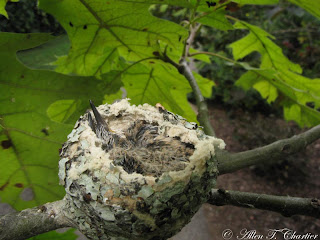The end of July is by no means the end of summer, as we're still seeing adult female Ruby-throated Hummingbirds carrying eggs, are only starting to see the first hatch-year birds at our feeders (and in our traps), and the post-breeding, pre-migration molt of body feathers has not yet begun. But, this is a convenient time to summarize the hummingbird banding results from June and July.
July 31 was the culmination of a year of planning for the Fourth Annual Michigan Hummingbird Festival. Temperatures were mercifully cool this year, with the morning starting out in the 60s, but with rain in the forecast. As predicted, very light rain began falling as our 3-hour hummingbird banding demonstration was to begin at 8:00 a.m. As a result, we did not open our Russell Trap, which tends to be the most productive trap. Instead we began cautiously by setting up two G-traps and two Dawkins Traps, which are cage-like aparatuses with feeders inside, and can be quickly checked and birds taken out easily. Banding was done under a canopy as in previous years, while I was under a different tent, educating the public by showing them the banded hummingbirds up close and personal. The photo below shows part of the gardens at the River Lake Inn Restaurant, where the festival has been held since 2007, with hummingbirds coming to their many feeders.
Click here to view a 35-second video of the activity at these feeders (taken July 24, 2010).
Although the rain stopped by 9:00 a.m., so many birds were being caught that there really was no time to open the Russell Trap. The results of the festival banding was 62 banded and 5 returnees from previous years, all ably banded by Brenda Keith and retrieved by "runners", Rich Keith and Phyllis Barents, while Jo Ellen Van Galder kept up with the fast-paced action as data recorder. Probably more than 1000 people attended this event, and many of them got to release a banded hummingbird. More than 100 people donated to our annual "adopt-a-hummer" event, and they'll receive a certificate showing the band number of their adopted bird, with notifications to follow should any be recaptured.
The total number of hummingbirds banded during June and July, based on standards adopted in previous years, was a very good total of 467, with an additional 79 returnees from previous years. Additional highlights from July included banding at a new locale in extreme northwestern Hillsdale County, where 36 were banded in just 90 minutes. Mary Bird's excellent hummer haven near Battle Creek produced an additional 39 new hummers banded, plus 14 more returnees from previous years. Our annual program at Lake Hope State Park in scenic southeastern Ohio netted 25 banded plus 3 returnees from 2008, and two new locales in Oxford, Oakland County showed some promise for the future. Jim and Melissa Pappas's hummingbird sanctuary produced a good number of birds after a slow start in June, and all sites in Waterloo Township, Jackson County continue to be very productive.
Some years, I am priviledged to be able to band nestling hummingbirds in the nest. This year, no less than FIVE nests came to my attention, but due to scheduling and other conflicts (including unexpected fledging at one nest), I could only visit one, which happened to be at a locally well-known nature center at the Fernwood Botanical Gardens in Berrien County, southwest Michigan. The nest was about 7-feet over a well-traveled foot path on a long, flimsy branch of an oak tree. I had indicated that perhaps it would not be a good idea for "media" to be informed of this event, but nature center visitors, and campers in the park, were very welcome. Probably 50 visitors watched the process of two baby hummingbirds being banded, and safely returned to their nest. They successfully fledged 5 and 7 days later, at the age of 20 and 22 days.
The coming six weeks, early August through mid-September, should see a big increase in captures as more young fledge, and all Ruby-throats begin preparations for southward migration.
Sunday, August 1, 2010
Subscribe to:
Post Comments (Atom)






2 comments:
I stumbled upon your blog and hope you can shed some light on why I have not seen any hummingbirds at all this year. Normally they are a continual presence in my yard, as I have many flowers and a couple feeders. This year I put in additional gardens and have tons of birds, including nesting bluebirds (!!), but not a single hummingbird. I live in Washtenaw County, Pittsfield Twp to be exact. Are you aware of any problem with the hummingbird population in this area? Thanks for any info you can provide.
Every year there are local variations on hummingbird numbers. Apparently, this year is your year to have fewer, as many places have had more. Conclusions about population trends should not be made based on a single year of increase or decrease, but on carefully documented long-term observations. Also, late summer often sees a decrease in activity at feeders as the females are busy feeding their young, catching insects and spending less time at feeders. They're never completely dependent on your feeders, and this period of their nesting cycle can result in less activity where you want to see them.
Post a Comment